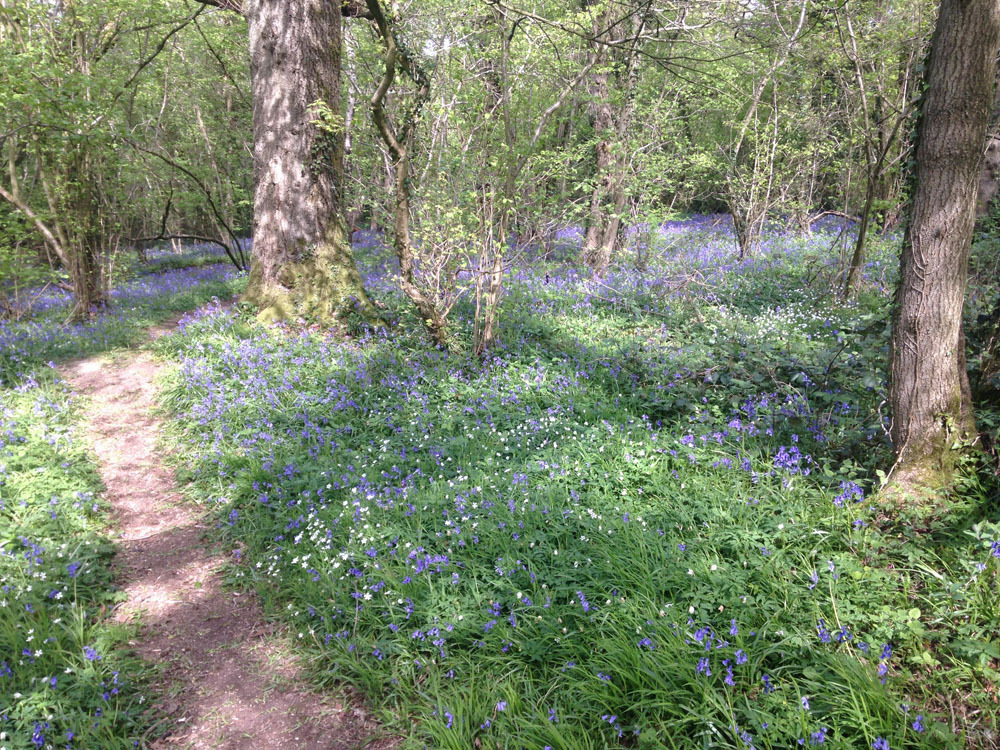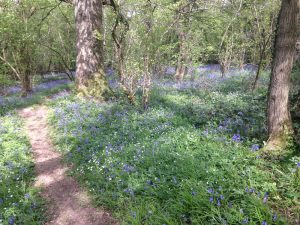
The bulky figure coming towards me on the path has a stick in one hand, a small bag in the other, but I can’t make out his face because the dappled light that filters through the trees in the wood is playing with his features. As with most people, my mind drifts when I go for long walks and I forget about my surroundings until something like the cackle of a crow or a breaking twig or the heavy tread of somebody approaching, snaps me out of my reverie and, for a nanosecond, I am in the grip of a timeless uncertainty. I think of bandits, pilgrims, squires and ploughmen but, by the time we are a few yards from each other, I see the pleasant face of what turns out to be a maths teacher on a weekend break. His rucksack contains a plastic bottle of water, which he finishes off in a few gulps, and his stick is one of those Nordic walking poles.
As a result of being glued to the television more often than usual because of the pandemic and of keeping two meters apart in town and on the streets, when out walking I find I am likelier to stop and make human contact with a stranger. After a brief socially-distanced conversation we continue on our way, me wanting to believe that this desire to amble or ramble or wander, will be a positive legacy of these strange times. Already 40% of those polled have vowed to continue with their walking activities once life gets back to normal.
Covid-19 and its progeny, social distancing and general lockdown, seem to have encouraged a greater interest in the outdoors and, because of the tranquillity imposed around us, birdsong seems louder, the air fresher, the skies somehow clearer, and an awareness of the landscape has surfaced as never before. Walking out on an early Sunday morning, while most are still in bed, is a pleasure anticipated, not only because you are guaranteed this new-found rapport with Nature but also because you have time to yourself for thinking. How this “thinking” manifests itself will vary: the unfocused, like me, will ruminate, the distressed may meditate, the measured thinker might deliberate and use the walk to reflect on one particular issue.
How easy it is to go walking in the countryside, though, depends on where you live. If you live in a small flat in central Manchester then it is a challenge, but should you live in a rural town like Ledbury in Herefordshire then it is only a question of stepping out onto the High Street and taking the steep path into Dog Hill Wood, which in turn takes you across Cut-Throat Lane and into Frith Wood where you can choose a path to follow, either one that doubles back to town, or one that ends at the Farmers Arms pub, or various others that connect with footpaths to form a network that gives a committed walker access to endless possibilities.
The walk I take is always along the same paths, and the certainty brought on by this repetition allows one to think without having to continually check the route, eyes on the ground, head in the clouds, so that at some point you suddenly realize that you are oblivious to your surroundings. As a consequence, when you do come out of your reverie, you stop to take it all in. Frith Wood last spring was carpeted with bluebells, but it is the white patches of stitchwort that attract the eye now. As you stand at the top of the wooded hill, glimpses of the Herefordshire countryside can be seen through the vertical gaps in the trees, and, beyond, the bordering county of Gloucestershire, rolling, verdant and tranquil. “Just as it must have been one hundred years ago,” you think to yourself, but only in the sense that there is no noise from traffic. The fields and meadows would have been much smaller, giving the land a patchwork quality, and there would have been more trees, more orchards and no tarmac.
And life would have been poorer—strikingly so.
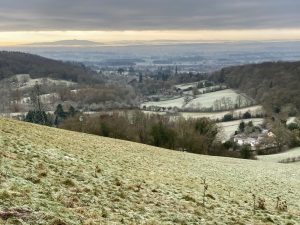
In 1914 even an ex-farmer from the USA, a certain Robert Frost, who knew what rural poverty was, seemed perplexed by what he witnessed. He wrote about this specific piece of England, with which he had become familiar, in a letter to his friend Louis Mertins, describing the destitution and deprivations of the people who “are used to living on black bread and rancid cheese, mitey cheese.” Nor could his American soul handle the forelock tugging of the common people, and the soporific class system that kept them in their place.
Nowadays, as our behavior on Facebook, Instagram and Twitter proves, any regard for one’s “betters” has long disappeared, and rural poverty is often measured by ease of access to transport, the internet and healthcare rather than by the material privations of 1914. And the plump figure coming towards you on the path turns out to be a maths teacher whiling away his time rather than an itinerant peddler selling his wares.
Like many thousands before him and since, Frost trampled this ancient web of paths, and his ghost is part of that invisible multitude of cartmen, hoboes, farriers, hawkers and drovers, though not the only poet, because his friend Edward Thomas would undoubtedly have been with him.
Frost and Thomas both possessed a real affinity for the countryside, never sentimental or romantic about actual rural life, but with a true knowledge of the natural world. Without a doubt Thomas was more of a walker than Frost, who would occasionally ask if there was much farther to go, but the walks these men took were sometimes twenty five miles long. We know they walked the eighteen miles to the Malvern Hills, and back, from the resulting poem “Iris by Night.” A walk would use up a whole day with talk of poetry, colleagues and the impending conflict in Europe. Frost referred to them as their “talks-walking.” I wonder if they tramped Frith Wood, only three miles from Little Iddens where Frost was living with Elinor and their four children? It is more than likely, given the hundreds of miles they covered together during that summer, a summer that had hanging over it the clouds of war, just as ours is stalked by the threat of Covid-19.
When, after a spell teaching at Harvard, Frost sold his farm and came to London, with only a few poems published in magazines in the US and in the hope of doing better in England, one of his great promoters was Edward Thomas, a “hack” writer of reviews and critical studies, as he described himself. “A Boy’s Will” was Frost’s first published book in 1913 and the subsequent “North of Boston,” also published by David Nutt of London, helped establish him on both sides of the Atlantic, and Thomas’s reviews were central to this.
Thomas had a reputation as an incisive critic but to make a living and support a young family he had to work hard—between 1900 and 1914 he reviewed 1200 books. When Frost was persuaded to leave Beaconsfield for a period of country living in the Gloucestershire / Herefordshire border, he did so in part to get away from the merely suburban, in part to please Elinor’s wish to “live under thatch,” and in part to be near the two “go-to” poets of the moment, Wilfrid Gibson and Lascelles Abercrombie, who had both established themselves in the area around Leddington. Frost wrote:
“When I can get rid of this house I am to go to Gloucester to live, to be with Wilfrid Gibson and Abercrombie. I am out with Pound pretty much altogether and so I don’t see his friend Yeats as I did. I count myself well out however. Pound is an incredible ass and he hurts more than he helps the person he praises.”
Thomas had already met Frost in London when he paid him a visit in Leddington in April 1914, on a cycling trip with his two older children, Bronwyn and Merfyn. The growing affinity between the two men led him to book a cottage (Oldfields) for the summer, three meadows away from the Frosts. He was a man who preferred the company of an individual to a group and the stimulus of walking and talking with a man he admired and liked would have been something to relish.
When nearly all conversations consist of emails or other digital transmissions and when two people imbibing differing views from a lit screen might as well live on different planets, where even a shared sense of reality, let alone a shared sense of wonder, no longer exists, the image of two men walking together and pondering their cultural inheritance is reassuring, even heartening. Our Covid world cannot really match the steady pace and slower rhythm of life in 1914, it can only hint at it as you stand in the middle of a hillside wood and contemplate the unfamiliar sluggishness of this rural panorama in 2021. What would you and I talk about? Covid, capitalism and cronyism? Instapoetry, graphic novels, fan fiction?
The Frost/Thomas talks-walks and the stimulating companionship they represent remind us that we are social creatures who yearn for friendship and that Covid has reduced our ability to reach out and be with others, to feel seen and heard. Zoom is no alternative. Yes, walking with another human being increases blood flow to the brain and bolsters our sense of well-being; we get to the point more quickly and our creative output goes up, but, more importantly, the more we communicate the more we discover within ourselves. It was this two-way conversation in motion that finally drew the poet out of Thomas and gave him the last push to free himself from the tedium of hack work. As Frost explained to Grace Walcott Corkling in a letter of 1921, “it was plain that he had wanted to be a poet all the years he had been writing about poets not worth his little finger… the point is that what we had in common we had from before we were born.”
For Frost and Thomas it was a question of escaping from the poetry of the day towards a poetry without rhetoric and formality. No posturing or gesturing or writing for an audience, the importance of the cadence of the human voice, a loosening and simplification not unlike the way people speak. Rhythms of speech were important—it is possible to generally understand a conversation even if the words themselves are not understood, and this is Frost’s “sound of sense.” During one walk, Frost stopped and shouted a question to a man two hedgerows away who was pitching manure. Whatever the question, the man could not have heard it, and he too shouted something back which they could not distinguish, but the cadence of the answer was as clear that of the question. Frost turned to Thomas; “That’s what I mean.” (Eleanor Farjeon, Edward Thomas: the last four years – Oxford Uni Press 1979).
Thomas, nudged along by Frost and finally liberated, began writing poetry at “36 in the shade.”
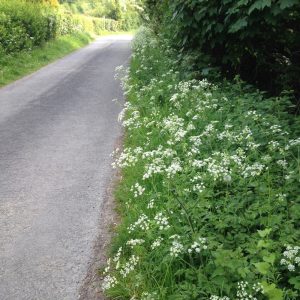
That such an important literary friendship was fostered by so much talks-walking comes as no surprise. For Robert MacFarlane, the writer and thinker, the space between the heel of one foot and the toe of another is not only a unit of progress but also of thought. He writes about the power of walking as thought-generator. “Footfall as a way of seeing the landscape; touch as sight.” He would have slotted in perfectly with Frost and Thomas on their walks, though I wonder if three might not be a crowd, better suited to sitting at a table at the Farmers Arms, each with a pint of country cider before him, a barrel of which everyone was expected to keep for visitors and any hired help.
Frost and Thomas suffered from periodic bouts of melancholy, the former prone to moodiness and domestic quarrelling, the latter, overworked and exhausted, would often resort to anger and occasionally to suicidal feelings. He was open about it to friends, saying things like, “we have been having a rotten time. I had a very persistent attack of depression… this made me unbearable at home.” He even found professional help from a future pupil of Jung’s. He eventually gave the sessions up, but kept looking to others for help until the arrival of the American offered a way forward. Try googling “walking as therapy,” and you will be introduced to a new and growing industry that offers counselling within a naturally therapeutic outdoor setting, combining physical exercise with psychotherapy. It claims to help reduce blood pressure and the risk of diabetes, as well as reducing anxiety and levels of depression.
Whether they were conscious of this or not, Frost and Thomas were just two of many “creatives” who, perhaps, instinctively knew that for depressives like them, walking was a means of lifting the mind out of darkness and allowing it to wander. A list of wanderers would include Dickens, Wordsworth, Nietzsche, Clare, Woolf, though they all walked alone, without the mutually supportive company of another who might cajole, tease, provoke, share an understanding and draw the best out of a companion, as Frost and Thomas did.
Cider drinking is on the up again after decades of neglected or grubbed-up orchards, with family-run enterprises producing subtly different tasting notes from the rough cider of a hundred years ago. The best known locally is Westons in Much Marcle who have been in business since the 1880s. ‘The Bounds’, the 17th century farmhouse and cider mill where it all began, is still the headquarters and is in the hands of the fifth generation of Westons. It is just four miles from Little Iddens,
No delivery trucks to distribute cider in the summer of 1914, just the slow horse-drawn drays taking up the width of the narrow roads, farm laborers in short-coats and leggings, perhaps Frost and Thomas’s children playing games or picking cherries in an adjoining field. Wilfrid Gibson’s poem “The Golden Room,” written years after the event, presents us nostalgically with all the poets gathered before war dispersed them, and refers to “…Again Frost’s rich and ripe philosophy / That had the body and tang of good draught-cider, / And poured as clear as a stream.” Westons might consider making a cider called Robert Frost, ideal for talks-walking.
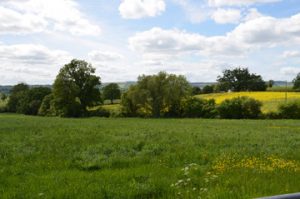
Here in Ledbury during our annual poetry festival, visitors wanting to share something of the spirit of the poets spend a morning walking to relevant spots in the surrounding countryside and listening to readings. For it is not only Frost and Thomas who spent time in this fertile land, so did the Poet Laureate John Masefield, who was born in Ledbury, Elizabeth Barrett Browning, who spent her childhood here, William Langland, who ploughed his field at the foot of the Malvern Hills while dreaming up Piers Ploughman and W.H. Auden, who married Erika Mann in the Ledbury registry office (but that is another story). It is an extraordinary confluence of significant poets for such a relatively small place.
Just as it is remarkable that one of the most, if not the most, widely read, quoted, and misquoted, American poems of the last hundred years or so was written here in the autumn of 1914 and set in the woods of Dymock, its first lines echoing Thomas’s opening of a short story of 1911: “Three roads meet in the midst of a little green.” It is Frost’s gentle mocking of his friend’s inability to be happy with a choice made when another might have turned out the better, a friend’s chiding of another’s indecision. Thomas often regretted not choosing the other path, always believing that it would have led to a better walk, with a greater variety of birdsong or finer wildflowers or better views. In “The Road not Taken” the paths “both that morning equally lay / In leaves no step had trodden black,” in other words, there was no difference in them, even if the narrator believes he has taken the one less travelled by. There is no morality tale here, just a tease, and Thomas missed the point until Frost pointed it out. Even then, Thomas took it badly, seeing it as an indication of his inability to choose between poetry and prose or between going to war or sailing for America.
Beset with indecision, Edward Thomas saw two choices ahead in 1914: enlisting to fight the war in Europe or going to the United States and starting anew, just as Frost had done in coming to England a few years earlier. With family matters at a low, finances as insecure as ever, trepidation at committing himself to a life with no guarantee of success, he chose the army. Once the commitment had been made his relief was palpable and his inner turmoil slowly settled into a stoical fatalism. He wrote his poetry during active service, until Easter Monday in 1917 when he was killed by a shell during the Arras offensive. He wrote 170 poems. You can read his letters at the Harry Ransom Center in Austin, Texas. Thomas’s “Poems” appeared in July 1917, three months after his death, and the title page dedication reads: “To Robert Frost.”
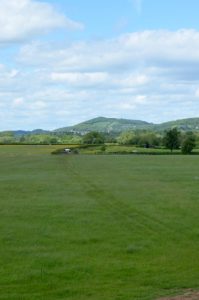
The famous Life photo of Frost in 1957, now a widower and an established literary figure, shows him standing in the field behind Little Iddens, hand covering eyes “in ache of memory,” as his granddaughter Leslie Lee Francis described. His former house is privately owned now, as is Oldfields and Gibson’s Old Nail Shop. The only one not standing is Abercrombie’s The Gallows. People still come and visit the area and join the organized walks on the Poets’ Paths in March when the wild daffodils bloom, though they are no longer picked and sold commercially as they were in the days of the poets. Loaded onto a train known as “The Daffodil Express,” it was big business, and Great Western Rail ran specials for the pickers who were mostly Roma from Kent.
If you walk the lanes near Little Iddens, you will come to a small hump-backed bridge which used to allow the Gloucester – Ledbury trains that carried Thomas and the daffodil pickers to pass under the Leddington road. The network was cut and dismantled in 1954 but if you stop on the bridge and look towards Ledbury you will still see the ghost of the railway tracks under the growing crops. I like to believe that Frost and Thomas’s ghostly footfalls still wander the hundreds of pathways in this corner of England, still stop at a gate, hesitate at a fork in the path, struggle up the Malvern Hills or slow down in the cool depths of a Dymock wood.
The Ledbury Poetry Festival runs from July 2 – 11, 2021. Learn more at https://www.poetry-festival.co.uk.
Peter Arscott was born in Peru, went to school in England and later studied at Bristol University before moving to Barcelona where he worked as a teacher and artist. He returned to live in London, working as a tourist guide and exhibiting at various galleries. He lives in Herefordshire and has an art and ceramics studio in Ledbury. He is a founder trustee of the Ledbury Poetry Festival. He has had stories published in The Common and Brittle Star.
Photos by author.
